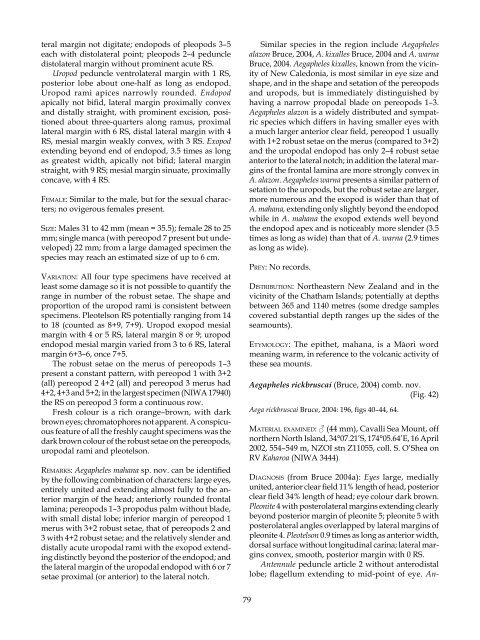The Marine Fauna of New Zealand: Isopoda, Aegidae (Crustacea)
The Marine Fauna of New Zealand: Isopoda, Aegidae (Crustacea)
The Marine Fauna of New Zealand: Isopoda, Aegidae (Crustacea)
Create successful ePaper yourself
Turn your PDF publications into a flip-book with our unique Google optimized e-Paper software.
teral margin not digitate; endopods <strong>of</strong> pleopods 3–5<br />
each with distolateral point; pleopods 2–4 peduncle<br />
distolateral margin without prominent acute RS.<br />
Uropod peduncle ventrolateral margin with RS,<br />
posterior lobe about one-half as long as endopod.<br />
Uropod rami apices narrowly rounded. Endopod<br />
apically not bifid, lateral margin proximally convex<br />
and distally straight, with prominent excision, positioned<br />
about three-quarters along ramus, proximal<br />
lateral margin with 6 RS, distal lateral margin with 4<br />
RS, mesial margin weakly convex, with 3 RS. Exopod<br />
extending beyond end <strong>of</strong> endopod, 3.5 times as long<br />
as greatest width, apically not bifid; lateral margin<br />
straight, with 9 RS; mesial margin sinuate, proximally<br />
concave, with 4 RS.<br />
femaLe: Similar to the male, but for the sexual characters;<br />
no ovigerous females present.<br />
size: Males 3 to 42 mm (mean = 35.5); female 28 to 25<br />
mm; single manca (with pereopod 7 present but undeveloped)<br />
22 mm; from a large damaged specimen the<br />
species may reach an estimated size <strong>of</strong> up to 6 cm.<br />
Variation: All four type specimens have received at<br />
least some damage so it is not possible to quantify the<br />
range in number <strong>of</strong> the robust setae. <strong>The</strong> shape and<br />
proportion <strong>of</strong> the uropod rami is consistent between<br />
specimens. Pleotelson RS potentially ranging from 4<br />
to 8 (counted as 8+9, 7+9). Uropod exopod mesial<br />
margin with 4 or 5 RS, lateral margin 8 or 9; uropod<br />
endopod mesial margin varied from 3 to 6 RS, lateral<br />
margin 6+3–6, once 7+5.<br />
<strong>The</strong> robust setae on the merus <strong>of</strong> pereopods –3<br />
present a constant pattern, with pereopod with 3+2<br />
(all) pereopod 2 4+2 (all) and pereopod 3 merus had<br />
4+2, 4+3 and 5+2; in the largest specimen (NIWA 7940)<br />
the RS on pereopod 3 form a continuous row.<br />
Fresh colour is a rich orange–brown, with dark<br />
brown eyes; chromatophores not apparent. A conspicuous<br />
feature <strong>of</strong> all the freshly caught specimens was the<br />
dark brown colour <strong>of</strong> the robust setae on the pereopods,<br />
uropodal rami and pleotelson.<br />
remarks: Aegapheles mahana sp. nov. can be identified<br />
by the following combination <strong>of</strong> characters: large eyes,<br />
entirely united and extending almost fully to the anterior<br />
margin <strong>of</strong> the head; anteriorly rounded frontal<br />
lamina; pereopods –3 propodus palm without blade,<br />
with small distal lobe; inferior margin <strong>of</strong> pereopod<br />
merus with 3+2 robust setae, that <strong>of</strong> pereopods 2 and<br />
3 with 4+2 robust setae; and the relatively slender and<br />
distally acute uropodal rami with the exopod extending<br />
distinctly beyond the posterior <strong>of</strong> the endopod; and<br />
the lateral margin <strong>of</strong> the uropodal endopod with 6 or 7<br />
setae proximal (or anterior) to the lateral notch.<br />
79<br />
Similar species in the region include Aegapheles<br />
alazon Bruce, 2004, A. kixalles Bruce, 2004 and A. warna<br />
Bruce, 2004. Aegapheles kixalles, known from the vicinity<br />
<strong>of</strong> <strong>New</strong> Caledonia, is most similar in eye size and<br />
shape, and in the shape and setation <strong>of</strong> the pereopods<br />
and uropods, but is immediately distinguished by<br />
having a narrow propodal blade on pereopods –3.<br />
Aegapheles alazon is a widely distributed and sympatric<br />
species which differs in having smaller eyes with<br />
a much larger anterior clear field, pereopod 1 usually<br />
with +2 robust setae on the merus (compared to 3+2)<br />
and the uropodal endopod has only 2–4 robust setae<br />
anterior to the lateral notch; in addition the lateral margins<br />
<strong>of</strong> the frontal lamina are more strongly convex in<br />
A. alazon. Aegapheles warna presents a similar pattern <strong>of</strong><br />
setation to the uropods, but the robust setae are larger,<br />
more numerous and the exopod is wider than that <strong>of</strong><br />
A. mahana, extending only slightly beyond the endopod<br />
while in A. mahana the exopod extends well beyond<br />
the endopod apex and is noticeably more slender (3.5<br />
times as long as wide) than that <strong>of</strong> A. warna (2.9 times<br />
as long as wide).<br />
prey: No records.<br />
distribution: Northeastern <strong>New</strong> <strong>Zealand</strong> and in the<br />
vicinity <strong>of</strong> the Chatham Islands; potentially at depths<br />
between 365 and 40 metres (some dredge samples<br />
covered substantial depth ranges up the sides <strong>of</strong> the<br />
seamounts).<br />
etymoLogy: <strong>The</strong> epithet, mahana, is a Mäori word<br />
meaning warm, in reference to the volcanic activity <strong>of</strong><br />
these sea mounts.<br />
Aegapheles rickbruscai (Bruce, 2004) comb. nov.<br />
(Fig. 42)<br />
Aega rickbruscai Bruce, 2004: 196, figs 40–44, 64.<br />
materiaL examined: ♂ (44 mm), Cavalli Sea Mount, <strong>of</strong>f<br />
northern North Island, 34°07.2 ’S, 74°05.64’E, 6 April<br />
2002, 554–549 m, NZOI stn Z 055, coll. S. O’Shea on<br />
RV Kaharoa (NIWA 3444).<br />
diagnosis (from Bruce 2004a): Eyes large, medially<br />
united, anterior clear field 11% length <strong>of</strong> head, posterior<br />
clear field 34% length <strong>of</strong> head; eye colour dark brown.<br />
Pleonite 4 with posterolateral margins extending clearly<br />
beyond posterior margin <strong>of</strong> pleonite 5; pleonite 5 with<br />
posterolateral angles overlapped by lateral margins <strong>of</strong><br />
pleonite 4. Pleotelson 0.9 times as long as anterior width,<br />
dorsal surface without longitudinal carina; lateral margins<br />
convex, smooth, posterior margin with 0 RS.<br />
Antennule peduncle article 2 without anterodistal<br />
lobe; flagellum extending to mid-point <strong>of</strong> eye. An-

















